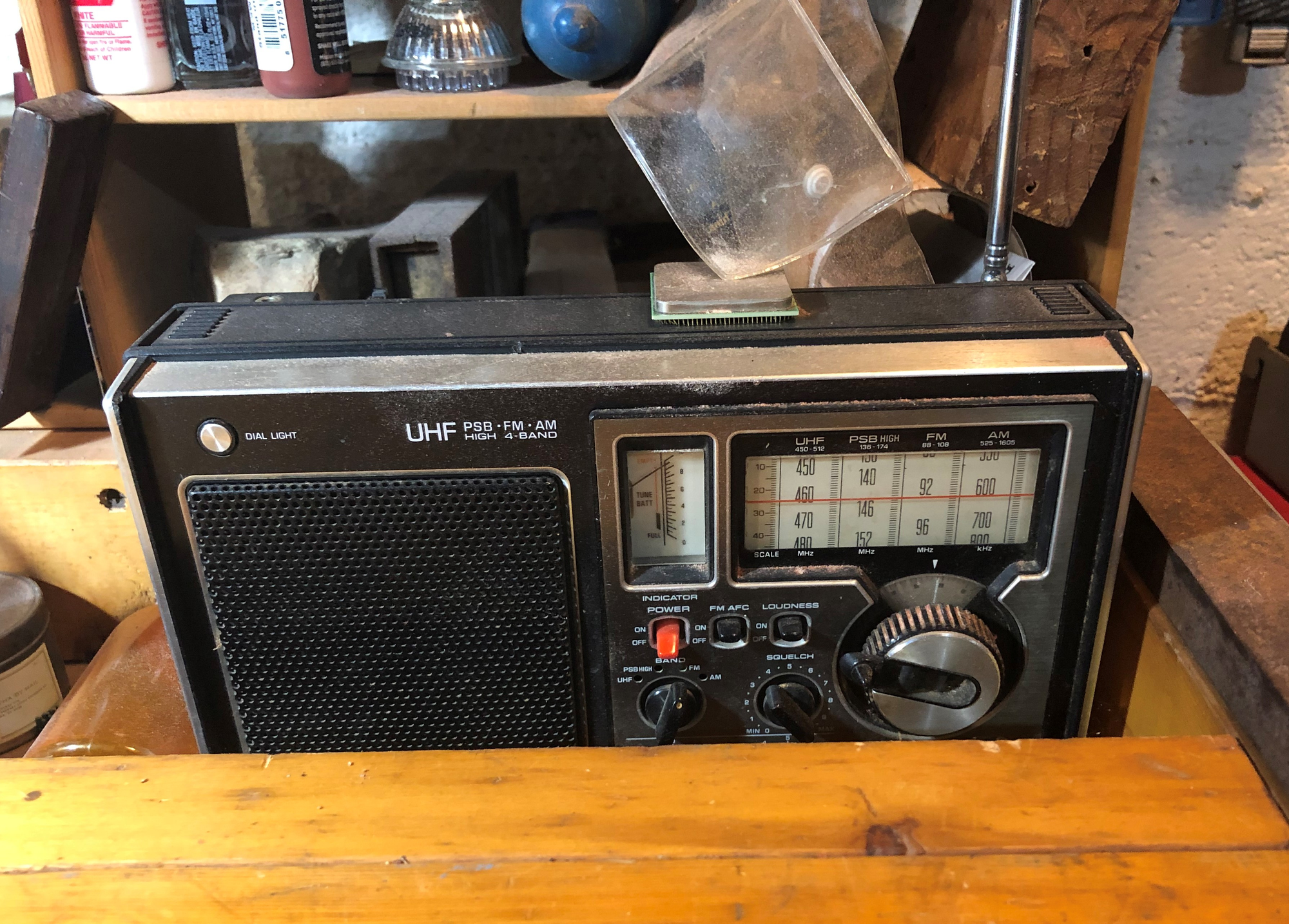Shop Radio
The takeaway There are plenty of options to protect your hearing and still stay connected to your music and phone. This article offers some solutions you can consider.

Tunes and projects go together
One thing I enjoy when working on projects is having some music or a game playing in the background. I have a Panasonic radio I purchased in 1977 for $35 that sits in my tool well and serves up classic rock while I tackle the current job. It is a robust, well-made radio and sports a lovely patina of shop dust. And, to you wags out there, it is not a vacuum tube model!
Taking the tunes outside the shop
When I take on outside projects, I have a small C. Crane radio I use to listen to football or baseball games.

Rocking like an elite operator
If music is my preference while working outside my shop, I use a combination of my iPhone and innovative ears-free headphones from Aftershox, the Aeropex (now Openrun). The nice thing about this combination is the ability to answer phone calls as necessary. That and how well it works! Check out the screen capture from the Aftershox web page below.

The Aftershox headphones use bone conduction technology to enable the wearer to listen to music and answer phone calls while leaving their ears uncovered and unblocked, allowing them to hear sounds from their environment while working.
Bone conduction technology is about as old as my Panasonic radio. Back in the second half of the last century (1979), a radio called the Bone Phone. The radio was contained inside a fabric covering that the wearer hung around their shoulders. The music was transmitted to the auditory sense via the bones in the body. The fad lasted until 1981 and faded away like the Chia Pet, Pet Rock and other "As Seen on TV" products. The cool part was how well it worked.
Aftershox's product is the result of a military requirement that certain forces retain audible situational awareness by leaving their ears open and still be able to make and receive radio messages. I tested a wired version at an electric cooperative as a hands-free way of answering their work cell phones. I also used them with my company cell phone while driving as it was against the law in that State to wear headphones or earbuds while driving. Why, you might ask, was that a law? So you could hear horns and sirens and take the appropriate action...like get the @#%* out of the way, or pull over.
Hearing protection
Every time you use power tools of any type, whether lawn or shop tools, you must wear hearing protection. This is as important as wearing eye protection in the same situations. Just do it and enjoy the full use of all your senses for a lifetime!
Damaging sound levels
Many of these products produce sound at harmful levels. If your ears ring after using one, the sound levels are damaging. Depending upon how long you are exposed to these sound levels determines if the damage is permanent or not. Check out the screenshot from my favorite iPhone sound meter app. It explains dB levels and their potential to damage hearing nicely. The danger zone starts around 80 dB.

Yes, this is part of my inner geek. So why aside from general curiosity, would a person want this capability? Simple, to answer a customer complaint. One of our customers was complaining about transformer noise from a new type of equipment we installed about 100 yards from his home. The equipment had a specified dB level that was very low and shouldn't have been an issue.
To resolve the complaint, I found the SPLnFFT Sound Meter in the Apple App Store and installed it on my iPhone. Over the course of several weeks, I collected sound level recordings, creating a nice chart showing location, time of day, weather conditions and so forth.
Presenting it to the customer, he seemed satisfied. To sweeten the deal, we planted some nice trees to screen the equipment further.
Nice tangent, right? But what does this have to do with shop and project tunes?
Quite a bit. Let's say you have earbuds or other-the-ear headphones. You might be tempted to wear them when using power tools and equipment. Or you may already be doing this. What is your first instinct in these cases? Turn up the volume so you can hear over the power tool. See where this is going? Yup, in order to hear over the power tool noise, you have to raise the volume to a higher dB level. You are doing more damage than the power tool by itself.
With my AfterShox, I don't have that risk. In fact, the headphones came with foam earplugs to use in high noise level environments. It is a nice solution and works perfectly for me.
Aftershox alternatives
However, you may prefer something else. That's where noise-canceling hearing devices come into the picture. If you take a walk through your local Home Depot, Lowes or Menards, you'll likely see over-the-ear noise-canceling headphones in the power tool aisles. One such example is the 3M WorkTunes Connect Hearing Protection. The model pictured below provides 24 dB of noise reduction while letting you listen to music and take phone calls.

3M products are always a good choice, IMHO, but I am biased. Look for competing products from major tool makers like Milwaukee, DeWalt, Ryobi and others.
Features to look for:
- Recharageble batteries
- Long battery runtime
- Maximum potential dB reduction
- Designed for use in DIY project settings
- Limits on the volume level of the headphones to avoid hearing damage
Can't I use any noise-canceling solution?
For the safety and protection of your hearing, I would say no. Products from companies like Bose and Beats are designed for use in normal sound conditions. Products like the 3M Worktunes are designed specifically for harmful noise level environments and must meet OSHA and other standards. Everyday products do not have to meet the standards. Plus, why would you want to take your premium audiophile gear into a dirty and dusty environment?
The takeaway
There are plenty of options to protect your hearing and still stay connected to your music and phone. Do yourself a favor and make the investment. You'll be glad you did.
